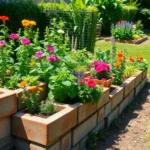Starting your first garden doesn’t have to feel overwhelming or intimidating. We’ve all been there – standing in the garden center surrounded by countless seed packets and wondering where on earth to begin. The truth is gardening is one of life’s most rewarding hobbies and it’s far easier than you might think.
Whether you’re dreaming of fresh tomatoes on your windowsill or planning to transform that bare patch in your backyard we’re here to guide you through every step. From choosing the right plants for your space to understanding basic soil needs we’ll break down everything into simple actionable steps.
The best part about gardening? You don’t need years of experience or expensive equipment to see amazing results. With just a few essential tools and our beginner-friendly tips you’ll be growing your own food and beautiful flowers in no time. Let’s dig in and discover how simple it can be to create your own thriving garden.
Choose the Right Location for Your First Garden
Location forms the foundation of every successful garden. We’ll guide you through the key factors that determine whether your plants thrive or struggle.
Assess Sunlight Requirements
Full sun areas receive 6-8 hours of direct sunlight daily, making them perfect for most vegetables like tomatoes, peppers, and squash. We recommend observing your yard throughout one complete day to identify these bright spots.
Partial sun locations get 4-6 hours of morning or afternoon light, supporting crops such as lettuce, spinach, and herbs. These areas work well for beginners who want to grow leafy greens.
Shade tolerant plants need only 2-4 hours of filtered light, including hostas, ferns, and some root vegetables like radishes. We suggest starting with sun loving plants since they typically produce higher yields.
Track sunlight patterns for at least one week before committing to a garden spot. Buildings, trees, and seasonal changes affect light availability throughout the year.
Consider Soil Drainage
Well draining soil allows water to penetrate easily without creating puddles. We test drainage by digging a hole 12 inches deep and filling it with water to see how quickly it disappears.
Poor drainage creates waterlogged conditions that rot plant roots and attract harmful bacteria. Clay heavy soils often hold too much moisture and need amendments like compost or sand.
Excellent drainage occurs when water disappears within 6-12 hours after heavy rain or watering. Sandy soils sometimes drain too quickly and require organic matter to retain adequate moisture.
Raised beds solve drainage problems instantly by elevating plants above ground level. We recommend this solution for areas with consistently wet or compacted soil.
Plan for Easy Access
Convenient location saves time and energy during daily garden maintenance tasks. We choose spots within 50 feet of our homes to make watering and harvesting simple.
Water source proximity reduces the hassle of carrying heavy watering cans or dragging long hoses across the yard. Gardens more than 100 feet from spigots often get neglected during busy periods.
Tool storage nearby keeps essential equipment like shovels, pruners, and gloves readily available. We place small sheds or storage boxes within easy walking distance of our garden beds.
Pathway planning prevents soil compaction from frequent foot traffic between plant rows. Wide walkways of 18-24 inches allow comfortable movement without damaging delicate seedlings.
Start with Easy-to-Grow Plants for Beginners

Now that you’ve selected the perfect location for your garden, it’s time to choose plants that’ll give you the best chance of success. We recommend starting with varieties that forgive mistakes and thrive with minimal intervention.
Herbs That Thrive in Any Garden
Basil tops our list for beginner herb gardeners because it requires minimal maintenance and produces aromatic leaves throughout the growing season. You’ll find this popular herb grows quickly from seeds or seedlings and tolerates various growing conditions.
Chives offer incredible hardiness and require virtually no special care once established. These perennial herbs return year after year and provide both flavorful leaves and beautiful purple flowers for your garden.
Low-Maintenance Vegetables
Radishes deliver the quickest results for new gardeners, with harvest ready in just 20 days from planting. These root vegetables grow easily in cool weather and signal success early in your gardening journey.
Spinach produces abundant leaves with minimal effort and thrives in cooler temperatures when other vegetables struggle. You can harvest outer leaves continuously while the plant keeps producing new growth.
Arugula grows fast and maintains itself with little intervention from busy gardeners. This peppery green adds flavor to salads and sandwiches while tolerating both cool and warm weather conditions.
Zucchini requires minimal care once planted and produces an abundance of squash throughout summer. These prolific plants need adequate space but reward gardeners with consistent harvests.
Tomatoes produce high yields when given proper support structures like cages or stakes. While they need some attention, the reward of homegrown tomatoes makes the effort worthwhile for most beginning gardeners.
Hardy Annual Flowers
Sunflowers create dramatic focal points and grow easily from seeds planted directly in full sun locations. These impressive annuals range from 3 to 16 feet tall and demonstrate remarkable drought tolerance once established.
Zinnias bring vibrant colors to gardens with minimal care requirements and simple seed starting methods. These cheerful flowers bloom continuously and attract beneficial pollinators to your garden space.
Marigolds earn their reputation as perfect beginner flowers through exceptional hardiness and foolproof growing habits. These reliable annuals tolerate various soil conditions and provide consistent blooms.
Coneflowers bloom for months while tolerating drought conditions that challenge other flowering plants. These perennial beauties return each year stronger and require minimal maintenance.
Impatiens thrive in partial shade areas where other flowers struggle and need minimal upkeep throughout the season. These colorful annuals provide continuous blooms in challenging growing conditions.
Morning glories climb and spread with ease while requiring minimal care from gardeners. These fast growing vines create beautiful screens and produce trumpet shaped flowers in various colors.
Understand Basic Soil Preparation Techniques
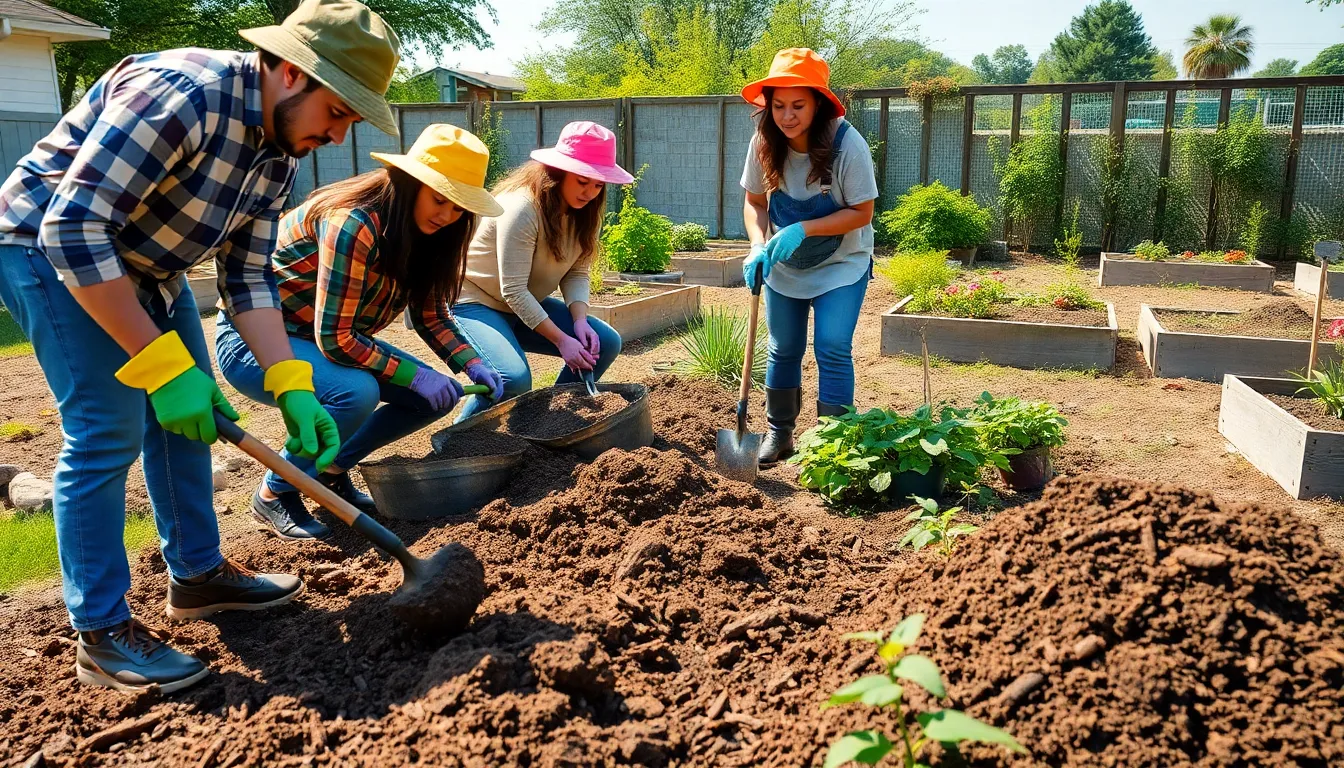
Proper soil preparation forms the foundation of every successful garden. We’ll start by loosening the soil to a depth of at least 8 inches, which allows plant roots to grow deeper and access more nutrients.
Test Your Soil pH
Testing your soil provides essential information about pH levels, organic matter content, phosphorus, and potassium availability. We recommend conducting this test before adding any amendments to understand what your soil actually needs.
Most vegetable gardens thrive when soil pH falls between 6.0 and 7.2, with 6.5 being the ideal target. Soil that’s too acidic or alkaline prevents plants from absorbing nutrients effectively, even when those nutrients are present in the soil.
Add Organic Matter and Compost
Adding a 2 to 3 inch layer of compost dramatically improves both soil structure and nutrient content. Organic matter serves dual purposes by loosening heavy clay soils while helping sandy soils retain moisture and nutrients.
We can incorporate aged manure, leaf mold, or kitchen compost to boost soil health naturally. Fresh organic matter should be mixed into the soil several weeks before planting to allow proper decomposition.
Create Proper Garden Bed Structure
Raised beds offer superior drainage and significantly reduce the risk of root rot in plants. We can build these beds 6 to 8 inches high using untreated lumber, stone, or other safe materials.
Clearing the planting area of existing vegetation and debris comes first when establishing new garden beds. Tools like sod cutters or sharp shovels make this process more efficient and thorough.
Raking the prepared soil ensures a smooth, debris free surface that’s ready for planting seeds or transplants.
Learn Essential Watering Practices for New Gardeners
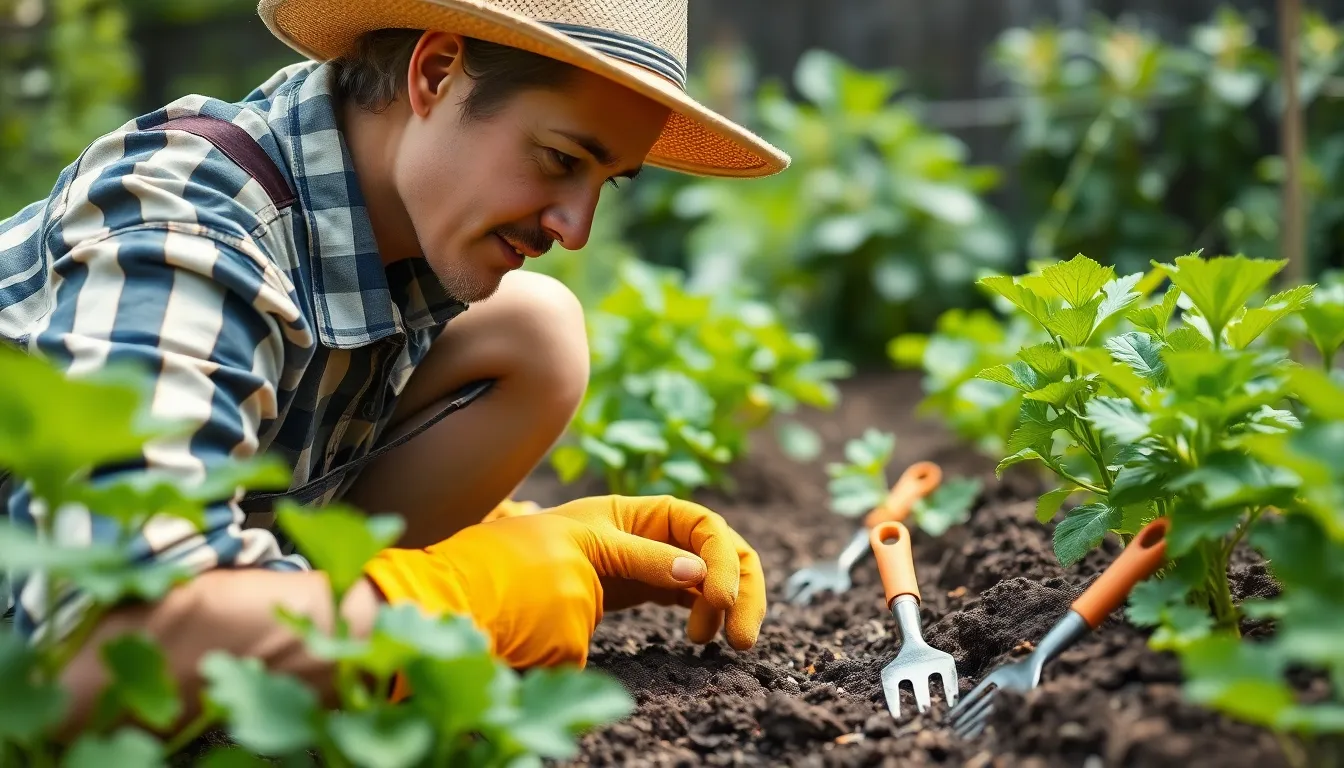
Watering might seem straightforward, but it’s one of the most critical skills we need to master as new gardeners. Getting this right will make the difference between thriving plants and struggling ones.
Establish a Consistent Watering Schedule
Check soil moisture before watering by inserting your finger into the soil up to the knuckle. When the soil feels dry at this depth, it’s time to water your plants.
Water deeply but infrequently to encourage strong root systems that can better withstand drought conditions. This technique helps plants develop robust root networks that reach deeper into the soil.
Schedule watering sessions when the top inch of soil feels dry, which typically occurs every 7 to 10 days during dry weather periods. We recommend creating a simple calendar to track your watering schedule until it becomes second nature.
Monitor weather forecasts to adjust your watering routine accordingly. Rain predictions can help you skip unnecessary watering sessions and prevent overwatering your plants.
Use Proper Watering Techniques
Avoid overhead watering methods that can wash away valuable topsoil and increase water loss through evaporation. Instead, use soaker hoses or direct water at the base of your plants.
Water in the morning hours to give plants the entire day to absorb moisture effectively. Morning watering also reduces the risk of fungal diseases that thrive in cooler, damp conditions.
Skip evening watering sessions since plants sitting in water overnight become vulnerable to fungi and root rot problems. Evening moisture creates ideal conditions for harmful bacteria to develop.
Use mulch around plants to retain soil moisture and suppress weed growth simultaneously. Organic mulches like straw or wood chips also improve soil quality as they decompose.
Consider rain barrels for collecting and reusing rainwater in your irrigation system. This sustainable practice reduces water costs while providing plants with naturally soft water.
Recognize Signs of Over and Under-Watering
Overwatering symptoms include several telltale signs that we need to watch for carefully:
- Yellow leaves that feel soft to the touch
- Droopy stems even though adequate sunlight
- Soft, mushy roots when examined closely
Underwatering indicators present differently and require immediate attention:
- Wilting leaves that appear limp and lifeless
- Crispy leaf edges that feel brittle when touched
- Dry, cracked soil that pulls away from container edges
Adjust watering frequency based on these visual cues rather than sticking rigidly to predetermined schedules. Plants communicate their needs through these physical changes, and we should respond accordingly.
Invest in Basic Gardening Tools Every Beginner Needs
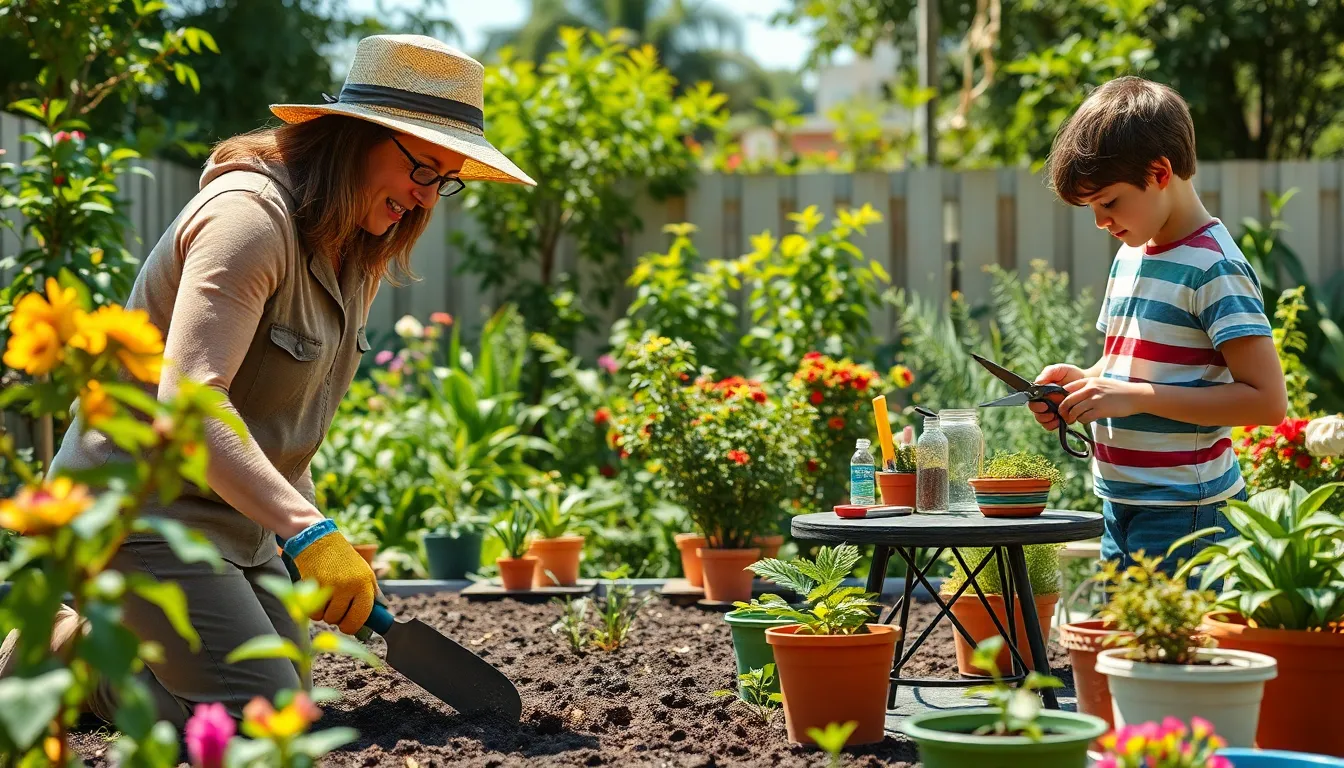
Now that we’ve covered location planning and soil preparation, we’ll explore the essential tools that make gardening tasks efficient and enjoyable.
Must-Have Hand Tools
Hand trowels serve as our most versatile companions for digging holes, transplanting plants, and breaking up soil clumps. We recommend choosing one with a comfortable grip since we’ll use it frequently for planting seedlings and bulbs.
Pruning shears keep our plants healthy by allowing us to trim small branches and remove dead growth. Look for models with hardened steel blades and adjustable handles that fit comfortably in your hands for extended use.
Gardening knives like the Hori Hori design excel at weeding and cultivating soil around established plants. These multipurpose tools often feature measurement markings that help us plant at proper depths.
Quality gloves protect our hands from thorns, rough soil, and potential irritants while we work. Choose breathable materials that allow dexterity for handling seeds and delicate plants.
Essential Long-Handle Tools
Long-handled shovels become necessary when we need to dig deeper holes for larger plants or move substantial amounts of soil. Spade designs work best for cutting through tough ground and creating clean edges.
Garden rakes help us level soil surfaces and remove debris like rocks, leaves, and weeds before planting. We’ll find them particularly useful for preparing seedbeds and maintaining garden pathways.
Hoes make quick work of weeding between rows and cultivating soil around growing plants. Choose a size that matches your garden scale and physical comfort level.
Budget-Friendly Tool Options
Second-hand purchases often yield quality tools at fraction of retail prices from garage sales, estate sales, and online marketplaces. Many older tools feature superior construction compared to modern budget options.
Seasonal sales provide opportunities to stock up on essentials during off-peak periods when retailers clear inventory. We recommend shopping end-of-season clearances for important savings.
Tool repair extends the life of inherited or damaged implements through simple maintenance like handle replacement and blade sharpening. Multi-purpose tools that handle various tasks reduce our overall investment while maximizing functionality.
Master Simple Pest and Disease Prevention
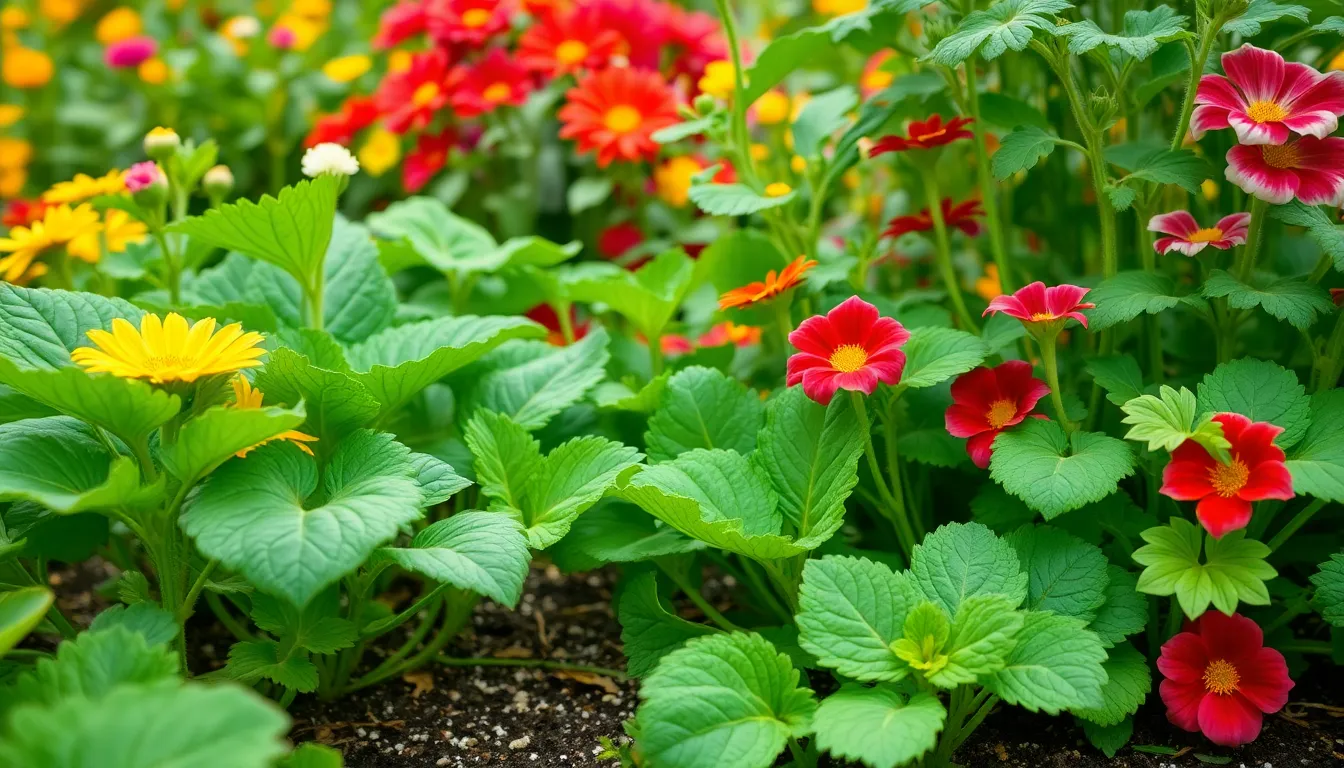
Protecting our garden from pests and diseases doesn’t require complex strategies or expensive treatments. We’ll focus on simple prevention methods that every beginner can master.
Identify Common Garden Pests
Aphids are small, soft-bodied insects that cluster on stems and leaves, feeding on plant sap and causing yellowing or curling foliage. These tiny pests multiply quickly and can weaken plants if left untreated.
Slugs and snails create irregular holes in leaves and flowers, leaving behind a telltale slimy trail. We often find these nocturnal pests hiding under mulch or garden debris during the day.
Caterpillars are larvae of butterflies and moths that chew through leaves, creating large holes or completely defoliating plants. Different species target various plants, from tomato hornworms on tomatoes to cabbage worms on leafy greens.
Use Natural Prevention Methods
Neem oil serves as our first line of defense against many garden pests, controlling aphids, whiteflies, and other soft-bodied insects without harming beneficial pollinators. Apply this natural insecticide in the evening to avoid affecting bees and other helpful insects.
Soap answers made from mixing 1-2 tablespoons of dish soap with a quart of water create an effective, mild pesticide for aphids and spider mites. Spray directly on affected plants, focusing on the undersides of leaves where pests often hide.
Diatomaceous earth acts as a natural powder that dehydrates and kills slugs, snails, and crawling insects when they come into contact with it. Sprinkle food-grade diatomaceous earth around plants or create barriers to protect vulnerable seedlings.
Companion planting offers long-term pest prevention by strategically placing certain plants together to deter harmful insects. Basil planted near tomatoes repels aphids and hornworms, while marigolds scattered throughout the garden help control nematodes and other soil-dwelling pests.
Know When to Seek Help
Severe infestations that cause important damage to multiple plants require professional intervention or expert advice from local nurseries. We shouldn’t wait until our entire garden is compromised before seeking assistance.
Persistent problems that don’t respond to natural methods after 2-3 weeks may need stronger interventions or different approaches. Local gardening experts can identify exact pest species and recommend targeted answers based on our regional growing conditions.
Plan Your Garden Layout for Maximum Success
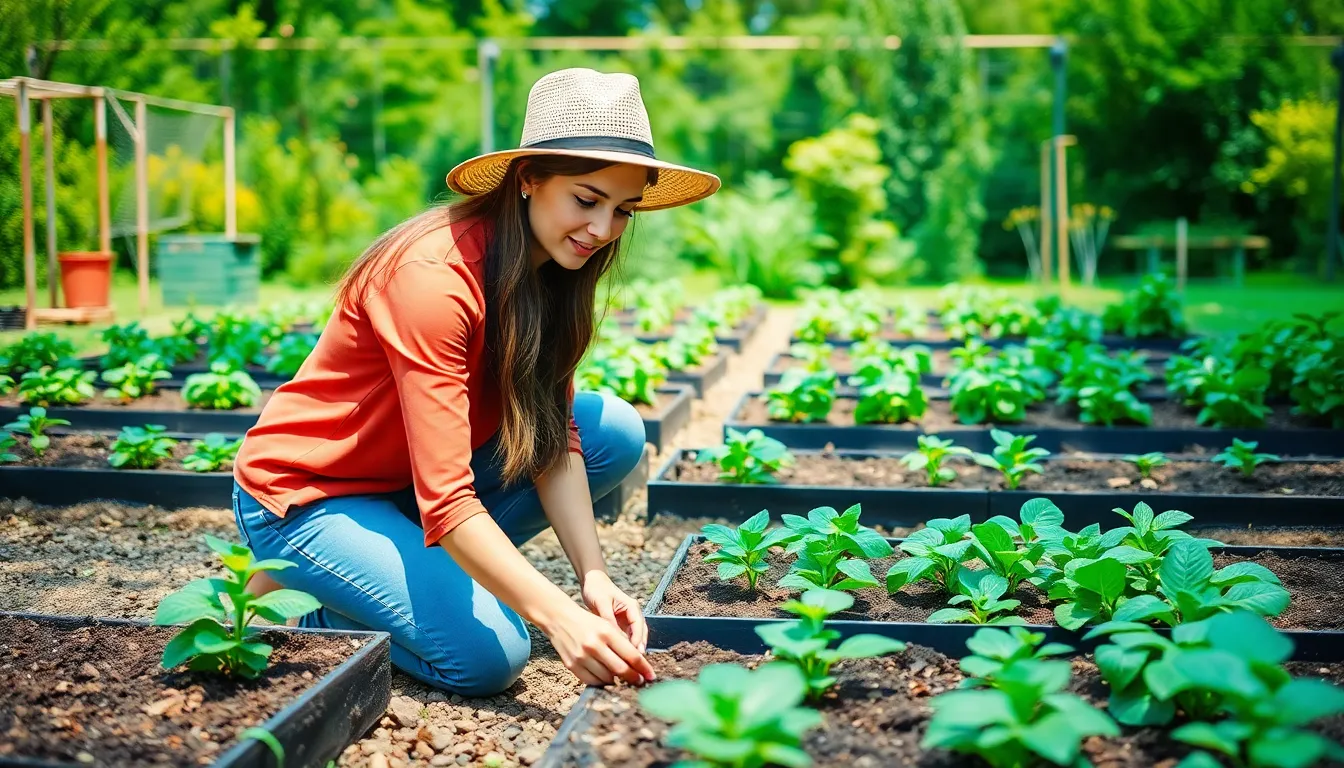
Creating a thoughtful garden layout sets the foundation for a thriving garden that’s both productive and easy to maintain. We’ll show you how strategic planning transforms your growing space into an organized, efficient system.
Design for Plant Spacing Requirements
Understanding plant spacing prevents overcrowding and promotes healthy growth. Different vegetables have exact space requirements that directly impact their development. Tomatoes need approximately 2-3 feet between each plant to allow proper air circulation and prevent disease, while lettuce requires only 6-8 inches of spacing for optimal growth.
Create a planting grid to visualize your garden layout effectively. Sketching out your space on paper helps you determine exactly how many plants fit in each section. This planning method prevents the common mistake of purchasing too many seedlings for your available space.
Consider mature plant sizes when positioning your crops. Bush varieties of squash spread about 3-4 feet wide, while vining types can extend 6-8 feet from their base. Planning for these growth patterns ensures each plant receives adequate sunlight and nutrients throughout the growing season.
Consider Companion Planting Benefits
Companion planting maximizes garden productivity by pairing beneficial plants together. This time-tested technique uses natural plant relationships to enhance growth, deter pests, and improve soil health. Marigolds planted alongside tomatoes naturally repel nematodes and other harmful soil insects.
Strategic plant combinations create natural pest control systems. Basil grown near tomatoes improves flavor while deterring aphids and hornworms. Carrots planted with onions benefit from the onions’ ability to repel carrot flies, while carrots help break up soil for onion root development.
Nitrogen-fixing plants improve soil fertility for neighboring crops. Beans and peas add nitrogen to the soil through their root nodules, making this essential nutrient available to heavy feeders like corn and leafy greens planted nearby.
Create Efficient Garden Pathways
Well-designed pathways provide easy access while protecting your soil structure. Wood chips, gravel, or stepping stones create stable walking surfaces that prevent soil compaction around your plants. These materials also help retain moisture in surrounding garden beds.
Strategic path placement ensures you can reach every plant without stepping on growing areas. Design pathways that allow you to access the center of each bed from multiple angles. Beds should be no wider than 4 feet so you can comfortably reach the middle from either side.
Permanent pathway materials reduce long-term maintenance and weed growth. Installing industry fabric under wood chips or gravel suppresses weeds while allowing water to penetrate the soil. This investment saves countless hours of pathway maintenance throughout the growing season.
Establish a Regular Maintenance Routine
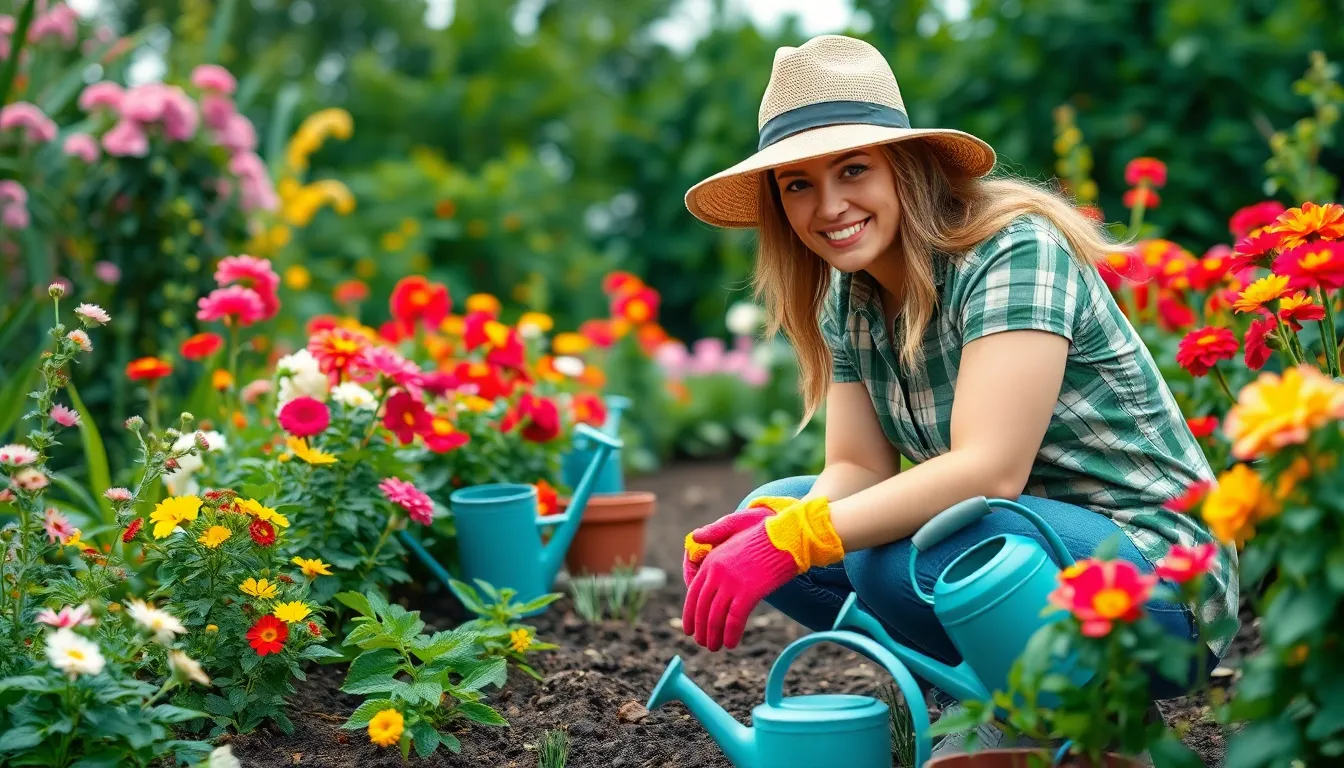
Successful gardening depends on creating and following a consistent maintenance schedule that keeps our plants healthy throughout the growing season. This routine approach helps us catch potential problems early while ensuring our garden continues to thrive with minimal stress.
Weekly Garden Care Tasks
Inspection forms the foundation of our weekly routine by checking each plant for signs of disease, pest damage, or stress. We should examine leaves for discoloration, spots, or unusual growth patterns that might indicate developing problems.
Watering requires checking soil moisture levels before adding water, ensuring plants receive adequate hydration without becoming waterlogged. Different plants have varying water needs, so we’ll adjust our watering schedule based on each variety’s requirements and current weather conditions.
Weeding prevents unwanted plants from competing with our crops for essential nutrients and growing space. Regular weed removal is much easier when weeds are small and haven’t established deep root systems.
Mulching helps retain soil moisture while suppressing new weed growth around our plants. We can apply organic mulch like straw, shredded leaves, or wood chips to maintain consistent soil temperature and reduce watering frequency.
Seasonal Maintenance Activities
Spring preparation involves working compost or organic matter into the soil, planting seeds according to our local frost dates, and applying balanced fertilizers to give plants a strong start. This season sets the foundation for our entire growing year.
Summer maintenance focuses on ensuring adequate watering during hot weather, pruning plants to promote healthy growth, and monitoring closely for pest activity when insects are most active. Regular harvesting also encourages continued production in many crops.
Fall cleanup includes removing spent plants and debris that could harbor pests over winter, adding fresh compost to garden beds, and planting cool season crops that thrive in cooler temperatures. We can also collect and store seeds from our best performing plants.
Winter protection involves covering tender plants with frost cloth or mulch, planning next year’s garden layout, and ordering seeds for the upcoming growing season. This quieter period allows us to reflect on the past year’s successes and challenges.
Record Keeping for Future Success
Planting dates documentation helps us track which varieties performed best when planted at exact times throughout the season. Recording this information allows us to optimize our planting schedule for better yields each year.
Soil conditions notes should include pH test results, amendments added, and how plants responded to different soil treatments. This data helps us understand what our exact garden location needs for optimal plant health.
Weather patterns tracking shows us how temperature, rainfall, and seasonal variations affected our plants’ performance. We can use this information to make better decisions about plant selection and timing in future seasons.
Pest issues records help identify recurring problems and track which control methods worked most effectively. Documenting when exact pests appeared helps us prepare preventive measures before they become established.
Successes and failures analysis provides valuable insights for improving our gardening techniques and plant choices. This honest assessment helps us repeat what worked well while avoiding strategies that didn’t produce desired results.
Conclusion
Starting your gardening journey doesn’t have to feel overwhelming when you break it down into manageable steps. We’ve covered everything from selecting the perfect location and preparing your soil to choosing beginner-friendly plants and establishing maintenance routines.
Remember that every experienced gardener started exactly where you are now. Your first season will teach you more than any guide ever could and that’s perfectly normal. Embrace the learning process and don’t be discouraged by initial setbacks.
The most important step is simply getting started. Pick a small area grab some basic tools and plant something that excites you. Your garden will grow alongside your confidence and before you know it you’ll be sharing your own gardening wisdom with other beginners.
Frequently Asked Questions
What are the best plants for beginner gardeners?
Start with easy-to-grow varieties that forgive mistakes. For herbs, try basil and chives as they’re hardy and low-maintenance. For vegetables, radishes, spinach, arugula, zucchini, and tomatoes offer rewarding yields with minimal care. Hardy annual flowers like sunflowers, zinnias, marigolds, and coneflowers add beauty while thriving with basic attention.
How much sunlight does my garden need?
Most vegetables require full sun (6-8 hours of direct sunlight daily) for optimal growth. Leafy greens like spinach and lettuce can tolerate partial sun (4-6 hours). Choose your garden location based on your preferred plants’ sunlight requirements, and observe your yard throughout the day to identify the sunniest spots.
What tools do I need to start gardening?
Essential hand tools include a hand trowel, pruning shears, and gardening knife for versatile plant care. For larger tasks, invest in long-handled tools like a shovel, rake, and hoe. You don’t need expensive equipment initially—look for quality second-hand tools at garage sales or seasonal discounts at garden centers.
How often should I water my garden?
Check soil moisture by inserting your finger 1-2 inches deep. Water deeply but infrequently to encourage strong root systems, typically 2-3 times per week depending on weather. Water at the plant base in early morning to reduce disease risk. Adjust frequency based on rainfall and seasonal changes.
How do I prepare soil for planting?
Loosen soil to at least 8 inches deep and test pH levels (ideal range: 6.0-7.2). Add organic matter and compost to improve soil structure and nutrients. Consider creating raised beds for better drainage and root health. Clear weeds and debris before planting, and ensure proper soil drainage to prevent waterlogged conditions.
What are common garden pests and how do I prevent them?
Common pests include aphids, slugs, snails, and caterpillars that damage leaves and stems. Use natural prevention methods like neem oil, soap solutions, and diatomaceous earth. Practice companion planting—for example, marigolds deter harmful insects. Regular plant inspection helps catch problems early before they become severe infestations.
How do I plan my garden layout effectively?
Create a planting grid to visualize spacing requirements and prevent overcrowding. Follow seed packet recommendations for plant spacing. Use companion planting strategies—tomatoes pair well with basil, while carrots grow nicely with onions. Design pathways for easy access and maintenance without compacting soil around plants.
What maintenance tasks should I do regularly?
Weekly tasks include inspecting plants for disease or stress, checking soil moisture, weeding, and applying mulch. Seasonal activities vary: spring soil preparation, summer watering and pruning, fall cleanup, and winter protection for tender plants. Consistent maintenance prevents small problems from becoming major issues.
Should I keep records of my gardening activities?
Yes, documentation is crucial for improvement. Record planting dates, soil conditions, weather patterns, pest issues, and harvest yields. Note what worked well and what didn’t. This information helps optimize future planting decisions, timing, and techniques. Simple notes in a garden journal or smartphone app work perfectly.







